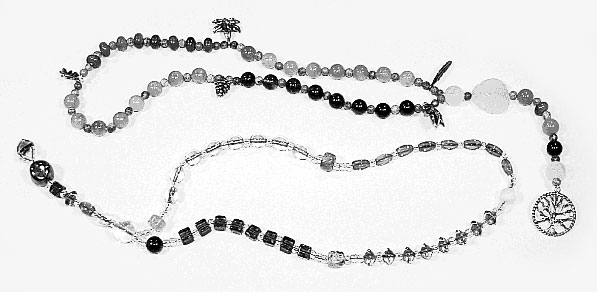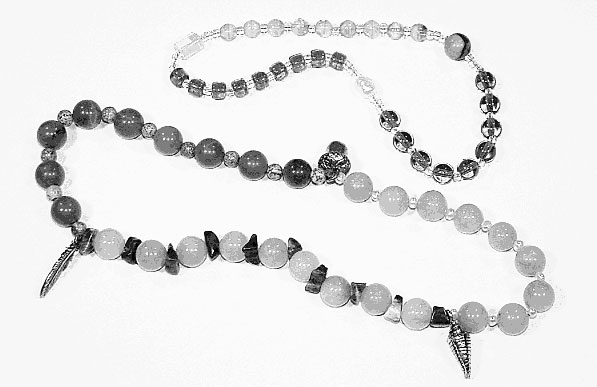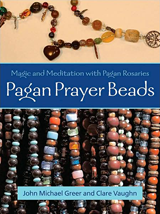Druidry is one of the fastest-growing branches of the modern pagan movement. Inspired by the ancient Druids, the priests and wizards of the ancient Celts, its roots as a living tradition lie in two places—the Druid revival of the 18th and 19th centuries and the Celtic Reconstructionist movement of the 20th century. Like other pagan religious movements, both branches of the Druid movement offer diverse traditions, teachings, and practices.
Four Elements Rosary

Druid Rosaries of the Four Elements
The Druid rosary of the Four Elements was originally designed by John Michael, and Clare Vaughn has revised and expanded the design in Pagan Prayer Beads: Magic and Meditation with Pagan Rosaries. This rosary gives practitioners in the Druid Revival tradition a versatile tool for working with the dance of meanings that surround the four elements, the four seasons, and the eight great festivals of the Druid year. The design includes beads that represent the four elements of the neo-pagan and Druid Revival traditions—air, fire, water, and earth. Echoing the elements themselves, these sequences of beads come together at a bead of spirit that leads down into the pendant.
The pendant consists of a second, larger spirit bead, one bead for each of the four elements, a final spirit bead, and a tree charm representing the multicultural concept of the Tree of Life. The beads are spaced for easy handling by stringing small beads between the primary beads. Five metal charms, representing the four seasons and the undying presence of spirit, are inserted into the design: a feather for spring, a flower for summer, a leaf for autumn, an acorn for winter, and an ivy leaf for that which endures through all seasons.
The beads are grouped in four octads (series of eight) to represent the eightfold Wheel of the Year in each of the four elements. They combine to make a circle of thirty-three beads that represents the thirty-three chief gods of the ancient Celts. Counting the pendant, the design includes a total of nine beads for each of the four elements and a total of three beads for spirit, because the numbers three and nine were of great importance to the ancient Celts. The number three is also the number of the Druid elements—nwyfre (spirit), gwyar (flow), and calas (solidity)—and the parent number of the numbers nine and thirty-three.
Three Realms Rosary

Druid Rosaries of the Three Realms
Just as the rosary of the Four Elements was created for the use of Revival Druids, so the Three Realms rosary was created for followers of Celtic Reconstructionism and other non-revival Druidic traditions. Clare Vaughn began developing the design shortly after the Four Elements rosary, and finalized the details after many philosophical debates with her friend Peter McDowell, whose practice looks back to the ancient Celtic cultures by invoking the three realms of land, sea, and sky instead of the four elements. The Three Realms rosary is a tool to work with the energies and imagery of this traditional cosmology.
The design includes beads to represent each of the realms, with spacers chosen to echo the unique characteristics of each realm. Three metal charms complete the symbolism: an acorn for land, a shell for sea, and a feather for sky. Unlike the rosary of the Four Elements, however the Three Realms rosary has no spirit beads and no pendant. It's design is a simple circlet.
The rosary's beads are grouped in three enneads (series of nine), reflecting the importance of these two numbers in traditional Celtic cultures. This is echoed by the three charms and thirty-six spacer beads. The total number of beads and charms in the rosary add up to sixty-six, a multiple of the great parent number three. The variant form of the design, with thirty spacer beads, adds up to sixty beads total, another multiple of three.
Other details of the design are also symbolic of ancient beliefs. To the Celtic people, the boundary between one realm and another was an intensely magical place, a liminal space or threshold where the normal rules are suspended and the Other World holds sway. One Irish hero who was trying to elude his enemies was advised to carry with him always a sack of sand and another sack of heather. This was so he might confuse people inland by saying he had slept with his head on the sea's sands the previous night, and while near the seashore he might create a similar confusion by saying he had slept with his head pillowed on heather. This gave him the appearance of being able to travel impossible distances, but actually he was engaging in an act of threshold magic. To emphasize this luminal quality in the places where two of the three realms join, the charms in the Three Realms rosary are placed between spacer beads from their own realm and spacer beads from the adjacent realm. Thus each realm stands in connection with the next, and each charm resides on the threshold, in liminal space.
Druid Rosaries » Pagan Prayer Beads » Pagan Prayer Beads: Magic and Meditation with Pagan Rosaries
John Michael Greer and Clare Vaughn (2007) Red Wheel/Weiser, LLC

